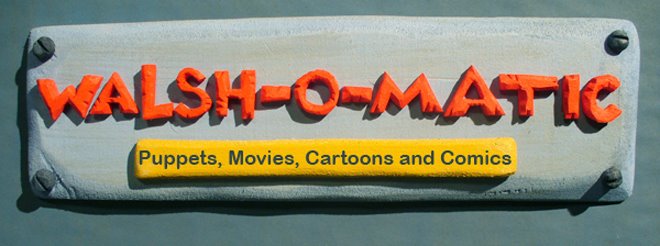
I'm very excited to see that Neil Burns' film Edison and Leo
is the opening film for the Canada First program for this year's Toronto International Film Festival, which runs September 3-14. This film marks an historic moment in the medium of stop motion animation in Canada: it is our first stop motion animated feature length film.
In a sense, this marks a sort of "arrival" upon the scene for the medium in this country. South of the border, and in Europe and the UK, we've seen numerous stop motion feature length projects (Nightmare Before Christmas, James And The Giant Peach, Curse Of The Were-Rabbit, the upcoming Coraline), but until this film's release, Canada has "only" produced shorts, TV series work, and TV specials. Canada produces some wonderful stop motion work (which of course I'll make every effort to profile on this blog), but a feature is, well... a feature.
A feature is a big budget endevour (I understand the film had a budget of $10 million, which buys a whole lot of puppet, trust me). And a project could only get that money if investors sincerely believed that they'd make that money back (and more, of course) through sales and broadcast. In other words, there's serious money to be made on stop motion in Canada. If there's money to made on something, there will be more of it.
What this film's existence also means is that a production model has now been established for feature work. It's one thing to short an indie short, in terms of complexity of production. Then it's something else to shoot a major TV series. Then, there's feature work. Once one feature has been shot in this medium, a template now exists for work flow in terms of pre-production, production, and post (not to mention promotion, distribution, and sales). What worked? What didn't? How can it be tweaked? And regardless of how buggy the flow might have been (which I actually know nothing about, so it might have been flawless) it happened. It got done, and it is out the door. That accomplishment brings with it a certain momentum. It's been done once, it flowed through a pipe-line. And that means it can happen again.
As far as a stop motion feature signaling that our nation has "arrived" in terms of crew abilities, Canada has been "feature ready" for years. We've got no shortage of artists and animators that can easily handle the demands of making something for the "big screen," so no worries there.
I'm sure the film will look gorgeous. And I'm sure it will have some wonderful character-based animation and gorgeous technical animation. But to a degree, all it takes to make something look nice is getting enough money to pay the right people to do what they do (using the proper facilities and equipment). What I really hope for is that the story is there. A feature-length story, if it sags, can sag big. And no amount of beautiful sets, props, lighting, music, puppets, and animation can cover for that.
What's encouraging is that the film's written (primarily) by George Toles, who has written scripts for a lot of Guy Maddin's films. This suggests certain adjectives when considering what the story might be like: mad-capped, frenzied, very unexpected, strangely funny, oddly tender. I suppose what I hope for is a certain amount of madness and oddity that is still somehow both character-based and driven. Considering one attribute of the main character is that he somehow hears through his teeth (darn those childhood accidents), it would seem the off-centredness is there. I just hope it also has heart, and that it makes me care about the characters.
If the story is wonderful, this film could do very well indeed. If it's less than wonderful? Well it's still time to celebrate for stop motion in Canada, for all the reason above and more. We'll see when it premieres and the reviews start rolling in.
Finally, I'm excited because of who is directing this historic film- Neil Burns. I've had the pleasure of working with Neil on a stop mo TV series a few years back. As with any production, it was a bit like trench warfare- keep your head down, do your job well, try to not get blown up. Neil was a bastion of calmness and good nature. He's an extremely talented, creative, and funny human being. And, I'm happy to report, he's a very nice human being as well.
Without allowing this posting to decay into that ever-beckoning vortex known as "cynicism," I can honestly say that it's not always the nice human beings that seem to get ahead in media production. It does, at times, seem that it's the very people who treat others unfairly by taking advantage of them or giving them the "Sure, but what have you done for me lately?" routine, that get ahead. This can become very discouraging, as the years go by and the jerks keep rising. Seeing bad behaviour rewarded doesn't particularly fill one with hope for mankind... nor for the world of media production.
Neil Burns is a nice person. And it's incredibly rewarding to see a nice person helming such an important project. Win-win.
You go, Neil!


